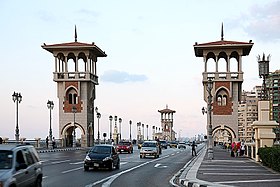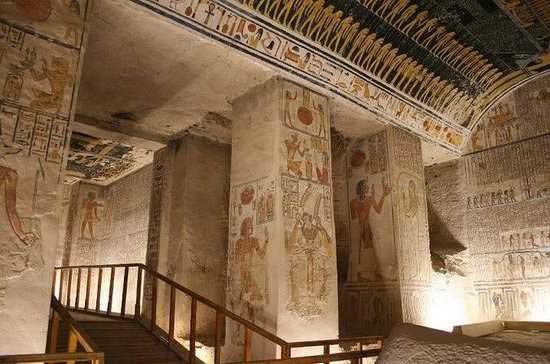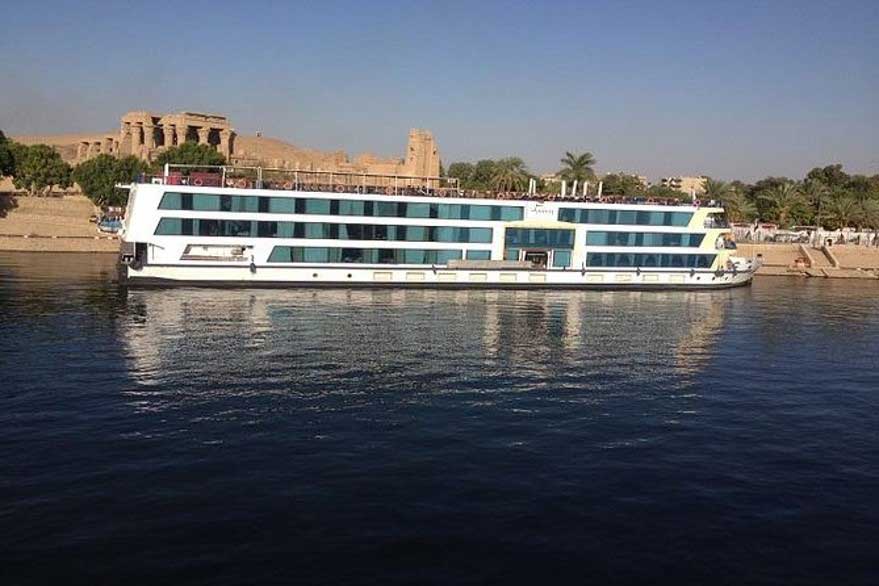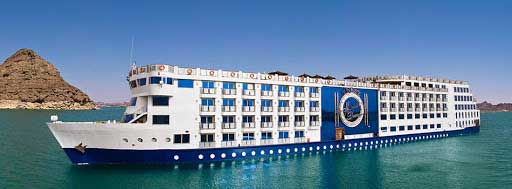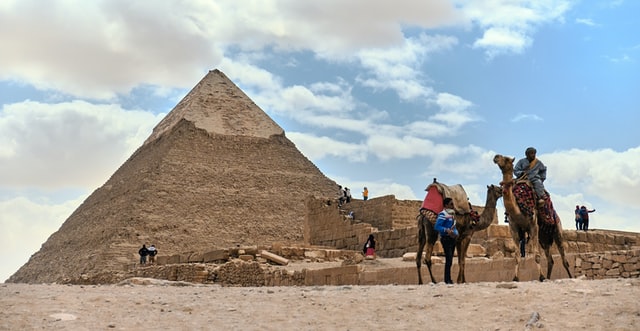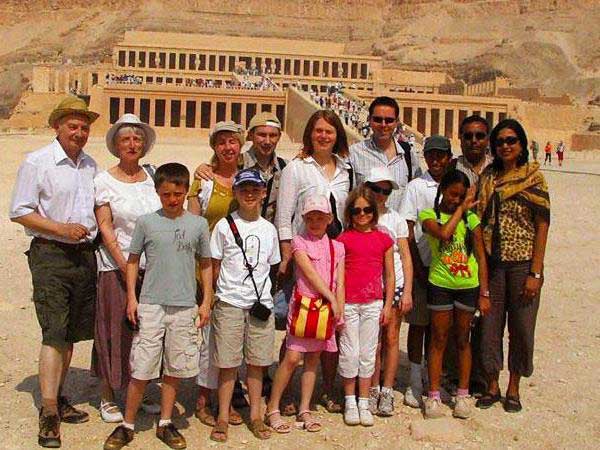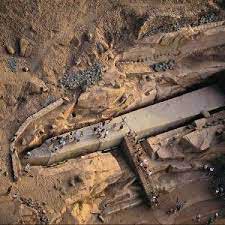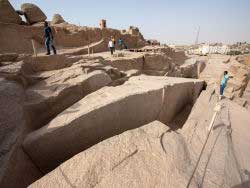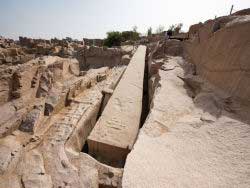The Unfinished Obelisk
Aswan was the source of ancient Egypt’s finest granite, used to make statues and embellish temples, pyramids and obelisks. The large unfinished obelisk in the Northern Quarries has provided valuable insight into how these monuments were created, although the full construction process is still not entirely clear. Three sides of the shaft, nearly 42m long, were completed except for the inscriptions. At 1168 tonnes, the completed obelisk would have been the single heaviest piece of stone the Egyptians ever fashioned.
At a late stage in the process, however, a flaw appeared, so it lies where the disappointed stonemasons abandoned it, still partly attached to the parent rock.
Upon entering the quarry, steps lead down into the pit of the obelisk, where there are ancient pictographs of dolphins and ostriches or flamingos, thought to have been painted by workers at the quarry. The Northern Quarries are about 1.5km from town, opposite the Fatimid Cemetery.
This article contains information for NON EGYPTIANS who wish to visit The Unfinished Obelisk site including:
- Where is the Unfinished Obelisk located?
- How old is the Unfinished Obelisk and who built it?
- Why didnt they finish it?
- Images from the Unfinished Obelisk site
- The best way for visiting the Unfinished Obelisk site
- How much does it cost to visit the unfinished Obelisk?
- Recommended Tours Including The Unfinished Obelisk
Where is the Unfinished Obelisk located?
AROUND THE UPPER EGYPTIAN CITY of Aswan are several ancient stone quarries, which were the source of Ancient Egypt’s finest granite. The Northern Quarries of Aswan holds the remains of the Unfinished Obelisk.
Had it have ever been erected, this obelisk would have been the largest one of Ancient Egypt and would have reached a stunning height of 42 meters. The largest finished obelisk, the Lateran Obelisk is 10 meters shorter than the Unfinished Obelisk, and today stands in Rome, Italy. Although not the largest obelisk, it is nevertheless the largest known monolith of Ancient Egypt, and one of the largest in the world, with an estimated weight of 1,200 tons.
How old is the Unfinished Obelisk and who built it?
It was built in a very unique manner as it depended on a Greek style of architecture as it had four sides converging to a mini pyramidal shape at the top of the obelisk, it was built in the new kingdom during the 18th dynasty by Queen Hatshepsut, the Wife of King Thutmose II (1478-1458 B.C) to be placed in the Karnak Temple and to complement the Lateran Obelisk, originally in Karnak but later moved to Rome. It is located in its original location a granite quarry in Aswan and would have measured 42 m making it the tallest obelisk in history but the project was unfortunately abandoned due to the discovery of numerous cracks in the obelisk. It would also have been the heaviest obelisk weighing 1200 tons. The obelisk was carved into the bedrock red granite and designed to resemble the primeval hill from the myth of creation where the world appeared for the first time.
Why didnt they finish it?
The work on the Unfinished Obelisk had been abandoned due to clearly visible cracks that appeared in the granite. The huge structure, which is partly connected to the parent rock, has been left in situ. The obelisk, together with several worker’s marks and rock carvings, provides a rare insight into the working techniques of Ancient Egypt. Virtually nothing is known about which pharaoh ordered the Obelisk and where it was supposed to be erected.
Is there any other obelisks in Egypt?
There are additional eight great Obelisks, which remain in Egypt today:
- Karnak temple, Thebes established by King Tuthmosis I.
- Karnak temple, Thebes established by Queen Hatshepsut, which is the second obelisk (fallen)
- Karnak temple, Thebes raised by Seti II (7m).
- Luxor temple established by Ramses II.
- Luxor Museum raised by Ramses II
- Heliopolis, Cairo raised by Senusret I.
- Gezira Island, Cairo established by Ramses II (20.4m high / 120 tons).
- Cairo International Airport established by Ramses II 16.97m high.
Visiting the Unfinished Obelisk
The Unfinished Obelisk makes for an impressive visit, if only to try and wrap your head around the idea of it being created by the ancient civilisation in ways we can’t even imagine today. If you’re visiting Aswan independently, pop to the nearby Fatimid Cemetery too, which has some fascinating 9th century mud-brick tombs. Otherwise, if you’re short on time, the easiest way to see the obelisk is to combine your tour with a visit to the other nearby monuments of the Philae Temple and the Aswan Dam.
How much does it cost to visit the Temple of Kom Ombo?
Tickets, which cost 140 Egyptian pounds (approximately $9) for adults and 70 Egyptian pounds (or $4.5) for students, can be purchased at the entrance’s visitors center. All tickets include access to the main temple of Kom Ombo and the crocodile museum.
The construction of the Unfinished Obelisk
The location that holds the obelisk is considered to be an open-air museum. The obelisk is able to tell us about the instruments used to construct this massive monument such as dolerite, a small ball made of a mineral harder than granite to carve the obelisk out. They also used many creative building techniques to spread the obelisk from the bedrock as they made some small cavities in the rock and those cavities were filled with wood chips. The chips were soaked with water. The soaking made expand causing the obelisk to detach from the base.
The obelisks created by the Ancient Egyptians are the subject of great debate between historians. The historic process of their manufacture is shrouded in questions – how were they carved in just one block? How were the thousand-ton monuments transported over hundreds of miles? And how were these immensely heavy columns raised into position once they arrived at their destination?
Numerous theories have been argued over the years that the obelisks were sailed up the Nile by boat… although that doesn’t explain how they were carried to the boats, or how the boats supported their weight! And of course, there’s always someone who comes up with the simple answer that the obelisks, like the pyramids, were not actually created by human hands but by extra-terrestrials… Hmmm – you can make your own mind up about that!
Recommended Tours including The Unfinished Obelisk:
Frequently asked questions about visiting Egypt
Is it safe to travel to Egypt
Is it safe to travel to Egypt?
Is Egypt Safe for Americans to Travel to
Is Egypt Safe for Americans to Travel to?
We get this question a lot at Bastet Travel In short, Americans and other visitors can rest easy: yes, Egypt is a safe country for tourists. And the rest of the world seems to agree — after years of middling numbers, tourism in Egypt is steadily rising towards its former highs, hosting over 9 million sightseers in 2018. The longer answer is worth exploring, though, and we have some assurances to offer all our clients who join us on all of our Egypt Travel Packages.Is a negative COVID-19 test (PCR and/or serology) required for entry?
- Yes.
- All passengers travelling to Egypt (including Egyptians) must be in possession of negative PCR test certificate for COVID-19, taken at a maximum of 72 hours before their flight departure time.
- Passengers travelling from Japan, China, Thailand, North America, South America, Canada, London Heathrow, Paris, and Frankfurt will be allowed to provide the test certificate performed at a maximum of 96 hours prior to flight departure, due to the long travel and transit period from these airports.
- Although we understand the PCR testing policy to require a test result performed no more than 96 hours before the original departing flight, we have received anecdotal reports that some travelers have been denied entry when their PCR test was performed more than 96 hours prior to the departure of their connecting flight.
- Travelers must present paper copies of the test results; digital copies will not be accepted.
- Children under the age of six of all nationalities are exempt.
Are PCR and/or antigen tests available for US citizens in Egypt?
Yes, at numerous private testing centers, as well as the Central Public Health Lab.
Has the government of Egypt approved a COVID-19 vaccine for use?
Yes
Which vaccines are available in Egypt?
AstraZeneca and Sinopharm.
Are vaccines available in Egypt for tourists to receive?
Yes, the media has reported that anyone over age 18, including foreign residents, can now register for the vaccine. There is limited supply of the vaccine available and the media reports that priority for the vaccine will go to the elderly and those with chronic illnesses.
Are test results reliably available within 72 hours?
Yes. Most test providers offer 48-hour turnaround. Faster service is possible at extra cost.
How can I obtain my Visa to visit Egypt?
How can I obtain my visa to visit Egypt?
What do i need to know when traveling to Egypt?
A few Things to Know Before Traveling to Egypt
You need a visa, and you can buy it upon arrival. The dollar goes far in Egypt. The traffic in Cairo/Giza is outrageous, but taxis (and Ubers) are cheap. You should not skip the Pyramids and Sphinx. The Pyramids and Sphinx are just the beginning of the ancient treasures. Islamic Cairo is amazing. Aswan should not be missed The Sahara is more than sand It is safer than you thinkWhat are the best day trips in Egypt
What are the most famous tourist attractions in Egypt
What are the most famous tourist attractions in Egypt?
Egypt has so much for travelers to see and do, it’s the perfect country for a mix of activities combining culture, adventure, and relaxation. Find the best places to visit with our list of the top tourist attractions in Egypt.- Pyramids of Giza
- Valley of the kings
- Luxor’s Karnak Temple
- The Egyptian Museum
- Christian and Islamic Cairo
- The White Desert and Baharyia Oasis
- Siwa Oasis
- Abu simbel Temples
- Aswan
- Alexandria
- St. Catherine’s Monastery
- The Nubian village
- Nile River Cruise
- Hurghada
- South of Sinai
Related Articles
Related
Seth
Also known as Set, Setekh, Suty and Sutekh, Seth was the god of chaos, darkness, violence, evil, deserts, storms, and one of the Osirian gods. In the Osiris myth, he is the murderer of Osiris (in some versions of the myth, he tricks Osiris into laying down in a coffin and then seals it shut.)
Ancient Egyptian Gods And Goddesses
For all ancient Egyptians, the world was filled with mystery. Much of what they experienced in the world around them was unknowable and frightening. The ancient Egyptian gods and goddesses represented aspects of the Egyptians’ natural and “supernatural” surroundings and helped them understand its many aspects.




